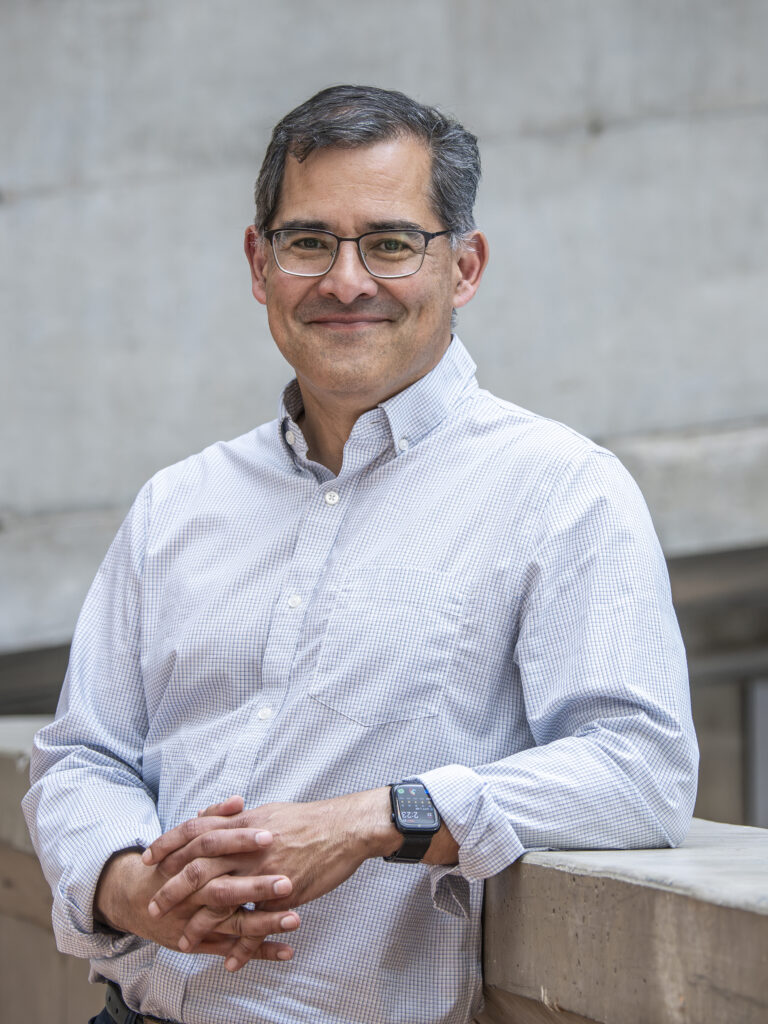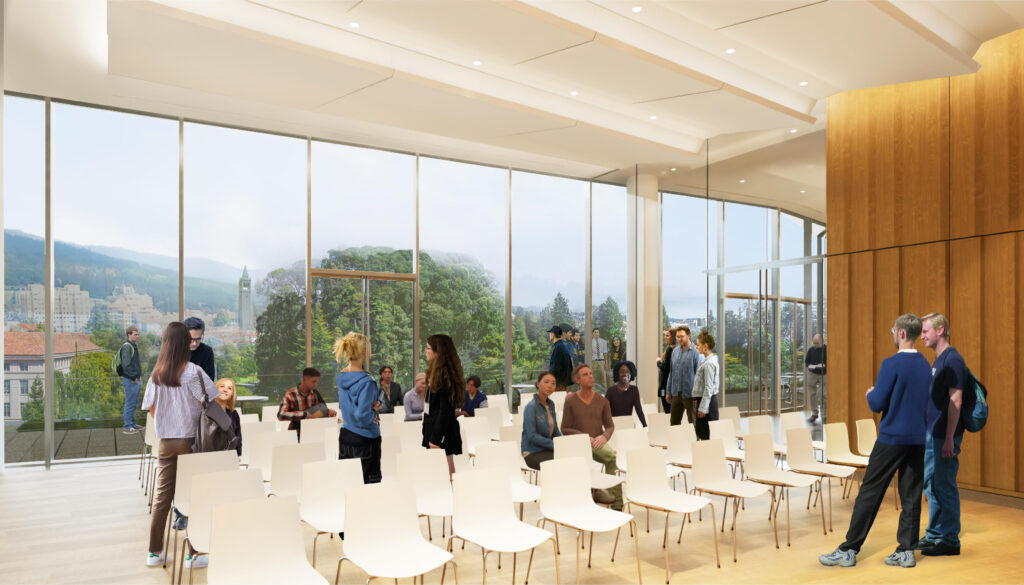UC Berkeley’s planned Innovation Zone on the west side of campus gained significant momentum as a result of the approval today (July 17) of a new laboratory building devoted to health and agricultural applications of CRISPR gene editing and growth space for entrepreneurial startups.
The UC Regents approved the Innovative Genomics Institute-Bakar Labs building during a regularly scheduled board meeting in Los Angeles. The seven-story building, supported by private philanthropy, is expected to open during the 2028-29 academic year. It will allow the Innovative Genomics Institute (IGI), founded 10 years ago by CRISPR co-inventor and UC Berkeley professor Jennifer Doudna, to expand in response to ever-growing applications of the revolutionary gene-editing tool. The IGI’s labs are currently located in a building on Berkeley Way, a block from the Innovation Zone.
“The IGI has doubled in size over the past five years, and this new facility represents a critical step in advancing our research capabilities,” said Doudna. “With dedicated space for new research projects and interdisciplinary collaboration, we can tackle increasingly complex questions in genome editing and accelerate the development of CRISPR applications that address real-world challenges.”
Glenn Ramit, IGI
The IGI-Bakar Labs building will also provide much-needed space for Bakar Labs startup companies that have successfully outgrown their incubator facilities and are ready to move to larger office and laboratory space, yet want to remain within the Berkeley ecosystem. The IGI-Bakar Labs building will be slightly larger than another Bakar Labs building, approved for the Innovation Zone site last year and scheduled for completion in late 2028, that will be an innovation hub focused on energy and new materials. When the new startup spaces are operating, the Bakar Labs sites will make up the largest incubator hub at any university in the nation. The incubators are open to all startups, not just those founded on UC Berkeley intellectual property.
“Once these buildings are complete, Bakar Labs is going to be over 400,000 square feet, by far the largest university-owned and -operated network of biotech, materials and energy tech incubators in the country,” said Bakar Labs director David Schaffer, a UC Berkeley professor of chemical and biomolecular engineering.
A startup culture
According to PitchBook, UC Berkeley graduates have founded more venture-backed companies than undergraduate alumni from any other university in the world.

Majed Abolfazli
“The university is an incredible fountain of discoveries and innovations and inventions, personified by the Innovative Genomics Institute, which has proven genome editing’s potential to transform healthcare, agriculture and climate adaptation,” said UC Berkeley Chancellor Rich Lyons. “Bakar Labs is an amazing public-private partnership that is crucial to transitioning Berkeley discoveries into the private sector so that society can benefit. By pairing IGI and Bakar Labs in the same building, we can amplify the successes of both.”
Having IGI research labs in the same building as Bakar Labs’ innovation space will allow crossfertilization and the opportunity for spinoff CRISPR-focused companies to settle nearby in incubator space. Already, IGI has spawned 26 companies that have garnered $4.8 billion in startup funding. Five of them were initially incubated in Bakar Labs’ space in Woo Hon Fai Hall on Bancroft Avenue.
“The Innovative Genomics Institute is a natural partner for the Bakar Labs ecosystem, and sharing the same building is going to expand and amplify that partnership,” Schaffer said. The partnership includes programming and support for entrepreneurs, some of which is provided by QB3, a multicampus UC institute that supports research and innovation and is directed by Schaffer.
Berkeley Innovation Zone
The Berkeley Innovation Zone is a 1.86-acre site between the western edge of the Berkeley campus and downtown Berkeley, The IGI-Bakar Labs building, encompassing about 169,000 gross square feet, will include space for wet labs and research and administrative offices, as well as meeting rooms and interaction areas. The seventh floor will include flexible collaboration and conference space and non-occupied mechanical areas, while the building’s western end will contain a partial, below-grade basement. A courtyard to the south will provide space for informal gathering and group events. The building is designed by a collaboration between DGA, an architectural firm specializing in research and laboratory buildings, and Weiss/Manfredi, an award-winning architectural and landscape design company.
IGI researchers recently announced the success of the first on-demand, personalized CRISPR therapy, which was delivered to a child barely seven months after birth and corrected a hereditary disease that often proves fatal. Earlier this month, the Chan Zuckerberg Initiative awarded the IGI a $20 million grant to deliver this treatment to eight new patients and expand its scope to treat eight other hereditary diseases that currently have no treatments.
“I expect a lot of informal but valuable interactions between IGI researchers and startup entrepreneurs in the Bakar Labs space,” said Brad Ringeisen, executive director of the IGI. “Now is the time to step on the accelerator to make sure recent advances in CRISPR have a real impact on healthcare.”
Another emerging field is CRISPR editing of the human and animal microbiomes. IGI researchers are currently targeting gut bacteria in humans to defang those that promote childhood asthma. They’re also targeting the bacteria that inhabit the guts of cows and other ruminants to decrease their production of the greenhouse gas methane.
“CRISPR editing of the microbiome opens up an entirely new class of therapeutics to promote health and treat chronic disease, but also a way to make agriculture and other sectors of the bioeconomy globally competitive and more sustainable, particularly through reduced methane emissions,” Ringeisen said.
Graduation space
Schaffer views the new innovation hub in the IGI-Bakar Labs building as “graduation” space for early-phase startups outgrowing their incubator space in Bakar Labs and, within a few years, the planned Bakar Labs for Energy and Materials. Currently, over 30 startups call Bakar Labs home, with half of them based on UC Berkeley discoveries and numerous others founded by UC Berkeley alumni. Once these companies expand to a few dozen employees, they need larger space that can only be had off-campus.

DGA + Weiss/Manfredi
Yet moving far from Berkeley cuts off access to many of the resources Bakar Labs offers, Schaffer noted. Since Bakar Labs opened in 2021 in the newly renovated Woo Hall, 15 companies have graduated to larger spaces around the Bay Area. In total, Bakar Labs companies have raised more than $630 million and have created over 400 jobs.
“Our incubator is an outstanding venue for a company to start, and eventually, companies get to the point where they want four walls and a door, they want their own contiguous space — which is just natural for a company that’s growing,” Schaffer said. “But when they move off-campus, while they may stay in touch, they lose access to all the resources and people and knowledge that the campus has. This new building is solving that. It’s being designed in a way that we can lease companies 2,500-square-foot modules but also allow them to grow to 5,000, 10,000, 15,000 square feet of space.”
Schaffer said that UC Berkeley has a vested interest in helping these startups succeed, not only because many leverage university discoveries, but also because, in some cases, the university has acquired equity in them. The campus often accepts equity shares in a startup in lieu of up-front licensing fees for use of campus intellectual property. The IGI-Bakar Labs community also benefits from BEVC, a venture fund embedded in the expanding Bakar ecosystem that partners with entrepreneurs to start and finance startup companies, among other VC funds affiliated with UC Berkeley.
“BEVC as well as the university have taken several approaches to invest in Bakar Labs companies,” Schaffer said. “This is positive for the companies, as it provides them resources and demonstrates confidence in their technologies. It also enables the university to further benefit from the long-term growth and success of technologies it often helped invent.”
CRISPR spinoffs are revolutionizing healthcare and agriculture
Since Jennifer Doudna co-invented CRISPR gene editing 13 years ago, UC Berkeley research on this breakthrough technology has generated dozens of innovative new companies. Some of the earliest were co-founded by Doudna — Caribou Biosciences, Mammoth Biosciences, Intellia Therapeutics — and now dominate the CRISPR healthcare landscape. Since she founded the Innovative Genomics Institute a decade ago, it has spun off another 26 companies that apply genomic approaches to health, agriculture and more. Among the newest startups from IGI that are or were incubated in Bakar Labs are:
- Azalea Therapeutics, currently in Bakar Labs, is developing in vivo delivery and other technologies related to CAR-T cell therapy.
- Verinomics, an alumnus of Bakar Labs, uses CRISPR technology to edit the genomes of plants to create specialty crops.
- Catena Biosciences, currently a tenant in Bakar Labs, has developed a new way to deliver anticancer drugs, focusing initially on solid tumors.
- Editpep, currently in Bakar Labs, uses a peptide-based delivery system to improve the targeting of CRISPR to treat specific diseases.
